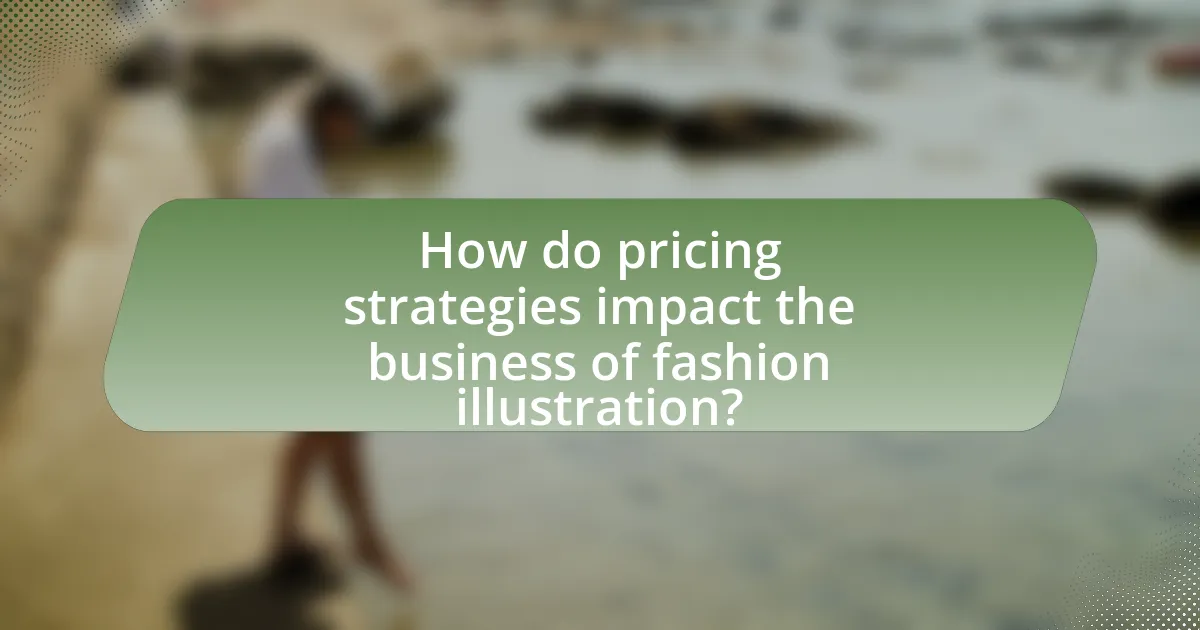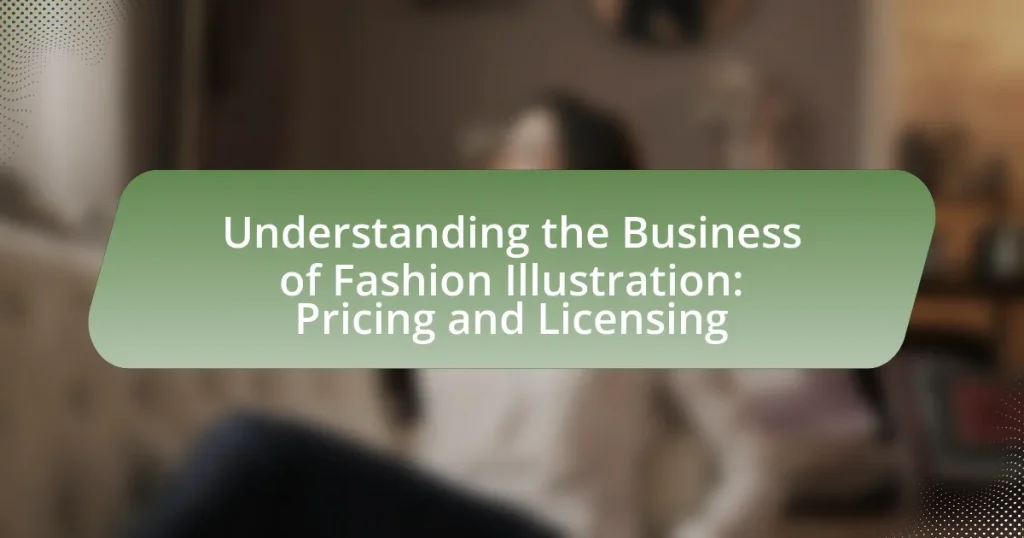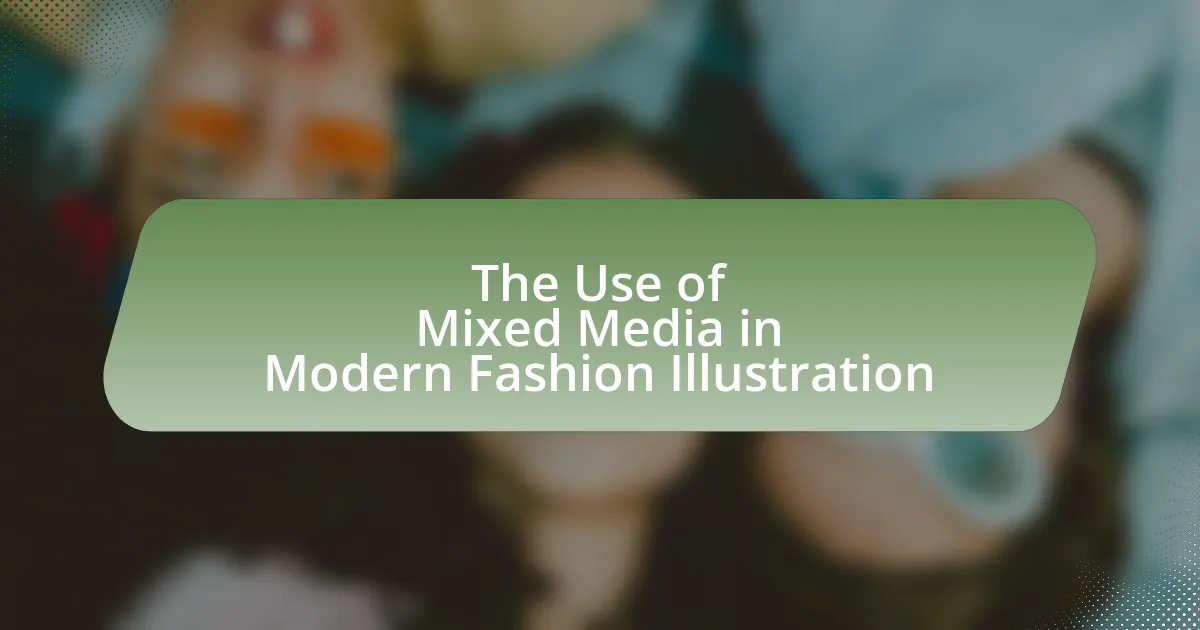The article focuses on the business of fashion illustration, detailing its role in the fashion industry, the evolution of the profession, and the intricacies of pricing and licensing. It highlights how fashion illustrators create visual representations that influence consumer perceptions and trends, while also generating revenue through various channels such as commissioned work and licensing agreements. Key components affecting pricing include the artist’s experience, illustration complexity, intended use, and market demand. The article also discusses different licensing options available to illustrators, best practices for negotiating terms, and common pitfalls to avoid in pricing and licensing strategies.

What is the Business of Fashion Illustration?
The business of fashion illustration involves creating visual representations of clothing and accessories for commercial purposes, primarily in the fashion industry. Fashion illustrators collaborate with designers, brands, and publications to produce artwork that conveys style, trends, and concepts, often influencing consumer perceptions and decisions. This sector generates revenue through various channels, including commissioned work, licensing agreements, and sales of original artwork. For instance, fashion illustrations can be licensed for use in advertising campaigns, editorial content, and product packaging, providing a significant income stream for illustrators. The demand for unique and compelling visual content in fashion marketing underscores the importance of this business.
How does fashion illustration fit into the broader fashion industry?
Fashion illustration serves as a vital communication tool within the broader fashion industry by visually conveying design concepts and trends. It bridges the gap between designers and consumers, allowing for the expression of creative ideas before garments are produced. Historically, fashion illustrations have been used in magazines, advertisements, and lookbooks, influencing consumer perceptions and trends. For instance, iconic fashion illustrators like René Gruau and David Downton have shaped the visual language of fashion marketing, demonstrating the significant impact of illustration on brand identity and consumer engagement. Thus, fashion illustration not only enhances the aesthetic appeal of fashion marketing but also plays a crucial role in the strategic positioning of fashion brands in a competitive marketplace.
What roles do fashion illustrators play in the fashion ecosystem?
Fashion illustrators play a crucial role in the fashion ecosystem by visually communicating design concepts and trends. They create illustrations that serve as a bridge between designers and consumers, helping to convey the aesthetic and emotional appeal of fashion collections. These illustrations are often used in marketing materials, lookbooks, and social media campaigns, making them essential for brand promotion and consumer engagement. Additionally, fashion illustrators contribute to the creative process by providing visual feedback and inspiration during the design phase, influencing the final product. Their work not only enhances the visual identity of fashion brands but also helps in establishing market trends and consumer preferences.
How has the role of fashion illustration evolved over time?
The role of fashion illustration has evolved from a primary means of communication in the fashion industry to a multifaceted tool that encompasses marketing, branding, and digital media. Historically, fashion illustrations were essential for conveying design concepts to clients and manufacturers before the advent of photography, with notable examples from the 19th and early 20th centuries, such as the works of Charles Dana Gibson and Erté. As photography became prevalent, the reliance on traditional illustration diminished; however, the resurgence of interest in hand-drawn art in the late 20th century, driven by a desire for authenticity and uniqueness, revitalized its importance. Today, fashion illustration serves not only as a creative expression but also as a strategic marketing asset, utilized in social media campaigns and branding efforts, reflecting the industry’s shift towards digital platforms and consumer engagement. This evolution highlights the adaptability of fashion illustration in response to technological advancements and changing market dynamics.
What are the key components of pricing in fashion illustration?
The key components of pricing in fashion illustration include the artist’s experience, the complexity of the illustration, the intended use of the artwork, and market demand. Experienced artists typically charge higher rates due to their established reputation and skill level. The complexity of the illustration, which encompasses the detail and time required to complete the work, also influences pricing; more intricate designs command higher fees. Additionally, the intended use—such as editorial, commercial, or personal projects—affects pricing, as commercial uses often require higher rates due to broader distribution and potential revenue generation. Lastly, market demand plays a crucial role; in a competitive market, prices may fluctuate based on the availability of artists and the specific needs of clients.
What factors influence the pricing of fashion illustrations?
The pricing of fashion illustrations is influenced by several key factors, including the artist’s experience, the complexity of the illustration, the intended use, and market demand. Experienced artists typically command higher prices due to their established reputation and skill level. The complexity of the illustration, such as the number of figures, detail, and color usage, also affects pricing, as more intricate work requires more time and effort. Additionally, the intended use—whether for commercial purposes, editorial content, or personal projects—can dictate price variations, with commercial uses generally leading to higher fees. Lastly, market demand plays a crucial role; when demand for fashion illustrations rises, prices tend to increase accordingly.
How do different styles of illustration affect pricing?
Different styles of illustration significantly affect pricing due to variations in complexity, technique, and market demand. For instance, highly detailed and intricate styles, such as realism or hyper-realism, often command higher prices because they require more time and skill to execute compared to simpler styles like minimalism or sketching. Additionally, certain styles may be more popular in specific markets, influencing their pricing; for example, digital illustrations may be priced differently than traditional hand-drawn works due to production costs and consumer preferences. According to a survey by the Association of Illustrators, 70% of illustrators reported that style directly impacts their pricing strategy, indicating a clear correlation between illustration style and market value.
What licensing options are available for fashion illustrators?
Fashion illustrators have several licensing options available, including exclusive licenses, non-exclusive licenses, and limited-use licenses. Exclusive licenses grant the client sole rights to use the illustration, often at a higher price, while non-exclusive licenses allow multiple clients to use the same artwork, typically at a lower cost. Limited-use licenses restrict the use of the illustration to specific purposes or timeframes, providing flexibility for both the illustrator and the client. These licensing structures enable fashion illustrators to monetize their work effectively while catering to diverse client needs.
What is the difference between exclusive and non-exclusive licensing?
Exclusive licensing grants a licensee sole rights to use a particular intellectual property, meaning the licensor cannot grant similar rights to others, while non-exclusive licensing allows multiple licensees to use the same intellectual property simultaneously. This distinction is crucial in the business of fashion illustration, as exclusive licenses often command higher fees due to their limited availability, whereas non-exclusive licenses typically result in lower fees and broader distribution opportunities for the licensor.
How can illustrators protect their work through licensing agreements?
Illustrators can protect their work through licensing agreements by clearly defining the terms under which their artwork can be used. Licensing agreements specify the rights granted to clients, including usage limitations, duration, and compensation, ensuring that illustrators maintain control over their intellectual property. For instance, a licensing agreement can restrict the use of an illustration to a specific project or time frame, preventing unauthorized reproduction or distribution. This legal framework not only safeguards the illustrator’s rights but also establishes a clear understanding between the illustrator and the client, reducing the risk of disputes.

How do pricing strategies impact the business of fashion illustration?
Pricing strategies significantly impact the business of fashion illustration by determining the perceived value of the artwork and influencing client demand. For instance, competitive pricing can attract a broader client base, while premium pricing may position an illustrator as a high-end artist, appealing to luxury brands. According to a survey by the Association of Illustrators, 70% of illustrators reported that their pricing directly affected their ability to secure projects, highlighting the importance of strategic pricing in maintaining a sustainable business. Additionally, pricing strategies can affect licensing agreements; illustrators who set clear and fair pricing are more likely to establish long-term relationships with clients, leading to repeat business and referrals.
What pricing models are commonly used in fashion illustration?
Common pricing models used in fashion illustration include hourly rates, flat fees, and royalties. Hourly rates are typically charged based on the time spent on a project, allowing flexibility for both the illustrator and the client. Flat fees involve a predetermined price for a specific project, providing clarity on costs upfront. Royalties are based on the sales generated from the illustrations, aligning the illustrator’s compensation with the commercial success of the work. These models are widely adopted in the industry, reflecting the diverse needs of clients and the varying scope of illustration projects.
How do hourly rates compare to project-based pricing?
Hourly rates typically provide a flexible pricing model based on the time spent on a task, while project-based pricing offers a fixed cost for the entire project regardless of the time invested. Hourly rates can lead to higher costs if a project takes longer than anticipated, as clients pay for each hour worked. In contrast, project-based pricing allows clients to know the total cost upfront, which can be beneficial for budgeting. According to a survey by the Freelancers Union, 60% of freelancers prefer project-based pricing for its predictability, while clients often favor it for cost control.
What are the pros and cons of different pricing strategies?
Different pricing strategies have distinct pros and cons that can significantly impact business outcomes. For instance, cost-plus pricing ensures a guaranteed profit margin but may lead to higher prices that deter customers. Conversely, value-based pricing aligns prices with perceived customer value, potentially maximizing revenue but requiring extensive market research to implement effectively.
Penetration pricing can quickly attract a large customer base, yet it risks lower profit margins initially. Skimming pricing allows businesses to capitalize on early adopters at higher prices, but it may limit market reach over time. Dynamic pricing offers flexibility to adjust prices based on demand, but it can confuse customers and erode trust if perceived as exploitative.
Each strategy’s effectiveness varies based on market conditions, competition, and consumer behavior, necessitating careful consideration and analysis for optimal results.
How can fashion illustrators determine their worth?
Fashion illustrators can determine their worth by assessing their experience, skill level, market demand, and the complexity of the projects they undertake. Experienced illustrators with a strong portfolio can command higher rates, as evidenced by industry standards where rates can range from $50 to $300 per hour based on expertise. Additionally, understanding the market demand for specific styles or techniques can influence pricing; for instance, unique or trending styles may allow illustrators to charge premium rates. Furthermore, the complexity of a project, such as the number of illustrations required or the intricacy of the designs, also plays a crucial role in determining worth, as more demanding projects typically justify higher fees.
What benchmarks can illustrators use to assess their pricing?
Illustrators can use industry standards, competitor pricing, and client budgets as benchmarks to assess their pricing. Industry standards provide a baseline for what is typically charged for various types of illustration work, often detailed in resources like the Graphic Artists Guild Handbook, which outlines recommended pricing based on experience and project type. Competitor pricing analysis involves researching what similar illustrators charge for comparable services, allowing artists to position their rates competitively. Additionally, understanding client budgets helps illustrators tailor their pricing to meet market demands and client expectations, ensuring their rates are both competitive and sustainable.
How does experience level affect pricing decisions?
Experience level significantly influences pricing decisions in fashion illustration, as more experienced illustrators typically command higher fees due to their established skills and reputation. For instance, a seasoned illustrator with a robust portfolio and industry connections can charge rates that reflect their expertise, often ranging from $100 to $300 per hour, compared to entry-level illustrators who may charge between $25 to $75 per hour. This disparity is supported by industry surveys, such as the Graphic Artists Guild’s Pricing & Ethical Guidelines, which indicate that experience correlates with higher pricing tiers, reflecting the value clients place on quality and reliability in creative work.

What are the best practices for licensing fashion illustrations?
The best practices for licensing fashion illustrations include clearly defining the scope of use, establishing fair compensation, and ensuring proper attribution. Clear definitions of usage rights, such as whether the illustration will be used for commercial purposes or personal projects, help prevent legal disputes. Fair compensation should reflect the artist’s experience and the market value of similar works, as evidenced by industry standards that suggest licensing fees can range from 10% to 50% of the retail price of the product featuring the illustration. Proper attribution is essential for maintaining the artist’s reputation and can be stipulated in the licensing agreement to ensure the artist receives credit in all uses of the illustration.
How can illustrators negotiate favorable licensing terms?
Illustrators can negotiate favorable licensing terms by clearly defining their rights and expectations upfront. This involves understanding the scope of usage, duration, and exclusivity of the license being offered. By researching industry standards and comparable licensing agreements, illustrators can establish a baseline for negotiations. For instance, according to the Graphic Artists Guild Handbook, illustrators should aim for terms that reflect the value of their work and the potential market reach of the project. Additionally, presenting a portfolio that showcases their unique style and previous successful projects can strengthen their position in negotiations.
What key elements should be included in a licensing agreement?
A licensing agreement should include key elements such as the scope of the license, duration, payment terms, and rights and obligations of both parties. The scope defines what is being licensed, whether it is exclusive or non-exclusive, and the geographical area of use. Duration specifies the time frame for which the license is granted. Payment terms outline the financial arrangements, including royalties or flat fees. Rights and obligations detail the responsibilities of the licensor and licensee, including usage restrictions and quality control measures. These elements are essential to ensure clarity and protect the interests of both parties involved in the licensing agreement.
How can illustrators ensure they receive proper credit for their work?
Illustrators can ensure they receive proper credit for their work by including clear copyright notices and licensing agreements in their contracts. By explicitly stating ownership rights and usage terms, illustrators protect their intellectual property and establish expectations for credit. For instance, the U.S. Copyright Office emphasizes that registering a work provides legal recognition and can deter unauthorized use. Additionally, using watermarks on digital images and maintaining a portfolio that showcases their work with proper attribution can further reinforce their claim to credit.
What common pitfalls should illustrators avoid in pricing and licensing?
Illustrators should avoid underpricing their work, as this can devalue their art and lead to unsustainable business practices. Setting prices too low may attract clients who do not respect the value of the work, resulting in a cycle of low compensation. Additionally, failing to clearly define licensing terms can lead to misunderstandings and potential legal issues. For instance, not specifying whether a license is exclusive or non-exclusive can create conflicts over usage rights. Furthermore, neglecting to consider the market rates for similar work can result in pricing that is either too high or too low, alienating potential clients or undervaluing the illustrator’s skills. These pitfalls can hinder an illustrator’s ability to build a successful and sustainable career in the competitive field of fashion illustration.
How can misunderstandings about licensing lead to disputes?
Misunderstandings about licensing can lead to disputes by creating confusion over the rights and limitations associated with the use of creative works. When parties involved in fashion illustration do not clearly define the scope of the license—such as duration, territory, and specific usage rights—misinterpretations can arise. For instance, if an illustrator grants a license for a specific project but the client assumes it includes broader usage rights, this discrepancy can result in legal conflicts. According to a study by the Copyright Office, improper licensing agreements account for a significant percentage of copyright disputes, highlighting the importance of clear communication and documentation in licensing arrangements.
What mistakes do illustrators often make when setting prices?
Illustrators often make the mistake of undervaluing their work when setting prices. This can stem from a lack of understanding of market rates, leading them to charge less than their skills and experience warrant. According to a survey by the Graphic Artists Guild, many illustrators earn significantly below the industry standard, which can perpetuate a cycle of low pricing within the community. Additionally, some illustrators fail to account for the full scope of their work, including revisions, usage rights, and the time invested in creating the artwork, resulting in prices that do not reflect the true value of their services.
What practical tips can help illustrators succeed in pricing and licensing?
To succeed in pricing and licensing, illustrators should conduct thorough market research to understand industry standards and competitor pricing. This involves analyzing similar artists’ rates and the types of licenses they offer, which can provide a benchmark for setting one’s own prices. Additionally, illustrators should clearly define their licensing terms, specifying usage rights, duration, and exclusivity to avoid misunderstandings and ensure fair compensation. Establishing a pricing structure based on factors such as experience, complexity of the work, and client budget can also enhance clarity and professionalism. According to a survey by the Graphic Artists Guild, 70% of illustrators who regularly review and adjust their pricing based on market trends report higher satisfaction and profitability.




